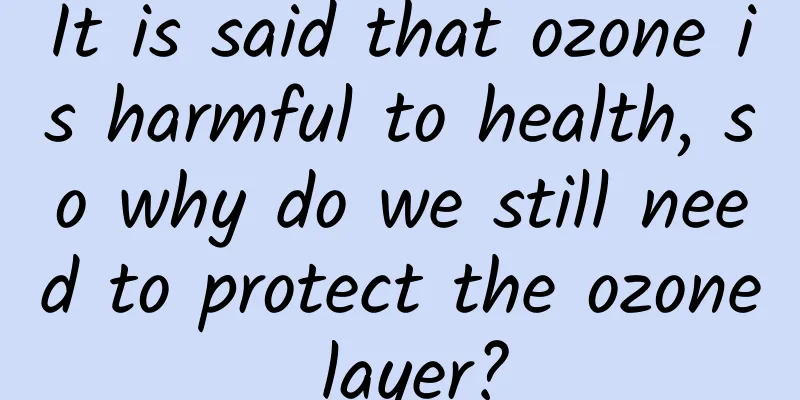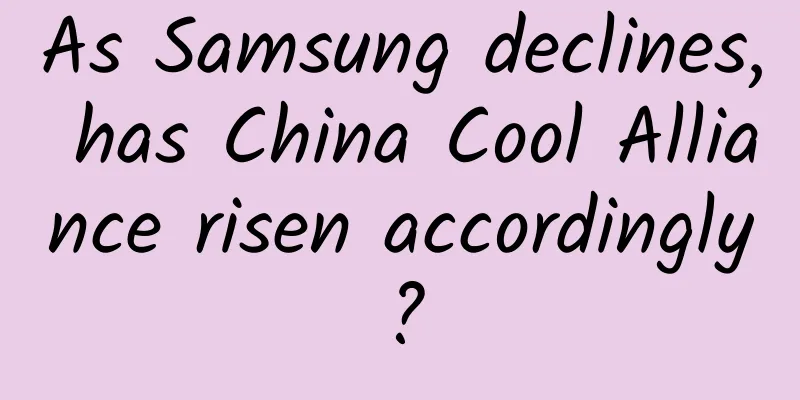It is said that ozone is harmful to health, so why do we still need to protect the ozone layer?

|
September 16 is the International Day for the Protection of the Ozone Layer. The ozone layer is known as the protective umbrella for the survival and reproduction of life on Earth. However, with climate change and the intensification of human production activities, this seemingly distant climate and environmental protection issue has gradually become closely related to our daily lives. What is the relationship between ozone and the ozone layer? Why do people often say that ozone is harmful to health, but they actively want to protect the ozone layer? Today, I will talk to you in detail about the significance of protecting the ozone layer. 01 Ozone, is it “good air” or “bad air”? Ozone is actually an "allotrope" of oxygen (a single chemical element with different properties due to different arrangements). The chemical formula of oxygen is O₂, while the chemical formula of ozone is O₃. It is named because it has a fishy smell and can be reduced to oxygen at room temperature. Copyright image, no permission to reprint Since ozone decomposes into oxygen and no secondary pollutants are produced during the conversion process, it has unique advantages in the fields of chemical production, medical care, aerospace, etc. However, ozone is harmful to the human body. After one hour of activity in an environment with high concentration of ozone, people will experience coughing, difficulty breathing and decreased lung function, and may even lead to weakened lung function, emphysema and lung tissue damage, which are often irreparable; ozone can also destroy the human immune function. If pregnant women are exposed to excessive amounts of ozone during pregnancy, the fetus will also be adversely affected. 02 "Earth's Shield" - the ozone layer, is of great significance to mankind The stratosphere at an altitude of 15-50 kilometers above the ground concentrates about 90% of the ozone on the earth. In the stratosphere at an altitude of 20-30 kilometers, the concentration is relatively high, with an average thickness of only about 3 mm. Don't underestimate this less than 3 mm ozone layer, it plays a significant role, equivalent to the "protective umbrella" of life on Earth, allowing visible light in sunlight to pass through, and can absorb more than 99% of harmful ultraviolet radiation, while converting it into heat energy, which has a warming effect on the atmosphere and has an important impact on the circulation of the atmosphere. Layered atmosphere infographic. The image is from the copyright library and is not authorized for reproduction. This explains the above problem. The "good" or "bad" of ozone is actually related to its location. Once it enters the ground, ozone will immediately change from a "guardian of the earth" to a "health killer." According to the "Ambient Air Quality Standards" issued by my country, when the maximum 8-hour average of ozone concentration exceeds 160 micrograms per cubic meter, ozone pollution is formed; if it exceeds 215 micrograms per cubic meter, it reaches moderate pollution. 03 How to fill the “holes” on Earth? (1) Let’s start with the Antarctic ozone hole First of all, the ozone hole is not a "hole", but an area of low ozone content. In the mid-1980s, scientists from the British Antarctic Expedition observed the ozone hole over Antarctica for the first time - the phenomenon of ozone thinning. This news caused panic around the world at the time and became one of the global environmental problems facing mankind. Changes in the extent of the ozone hole observed from 1979 to 2012 Image credit: NASA Changes in solar radiation intensity caused by solar activity, atmospheric movement, atmospheric temperature and other factors will affect ozone concentration and distribution. At the same time, since the Industrial Revolution, in the process of rapid development, substances that deplete the ozone layer have been invented, produced, applied, consumed, and discharged... Ozone in the atmosphere can react with many substances and be consumed and destroyed. The most common ones are several chemicals containing carbon, hydrogen, chlorine, and nitrogen. This reaction consumes ozone in the stratosphere, breaks the balance of ozone, and leads to an increase in ground ultraviolet radiation, which brings a series of problems to the earth's ecology and humans. Scientists further discovered that the reduction in the thickness of the ozone layer is related to a class of artificial compounds called chlorofluorocarbons (CFCs), which are mainly used in sprays and cooling equipment. (2) Refrigerants, an eternal topic of environmental protection Chlorofluorocarbons, commonly known as Freon, are released into the atmosphere, where they release chloride ions under the irradiation of strong ultraviolet rays at high altitudes. The free chloride ions and the extremely unstable ozone decompose into oxygen and hypochlorite ions. Two hypochlorite ions decompose into free chloride ions and oxygen when exposed to light. This cycle repeats itself, and one chloride ion can decompose thousands of ozone into oxygen, causing the depletion of the ozone layer. As early as 1974, scientists predicted that if the production of chlorofluorocarbons continued to increase at an annual rate of 22% and was eventually released into the atmosphere, the total amount of global ozone would drop by 5% by 1995. Subsequent satellite and ground observation data confirmed this prediction. In 1921, Willis Carrier, the "father of air conditioning", invented the first commercial centrifugal refrigerator, ushering in a new era of refrigeration and air conditioning. In the 1930s, a number of halogenated hydrocarbon refrigerants emerged, which greatly surpassed previous refrigerants in terms of safety and performance. DuPont named them Freon. In the following decades, as the refrigeration and air conditioning industry grew into a multi-billion dollar industry, chlorofluorocarbons (CFCs) and hydrochlorofluorocarbons (HCFCs) refrigerants accounted for a very high proportion. Copyright image, no permission to reprint On September 16, 1987, in order to prevent the damage of chlorofluorocarbon compounds in industrial production to the ozone layer, the United Nations invited 26 member states to sign the Montreal Protocol on Substances that Deplete the Ozone Layer (hereinafter referred to as the Montreal Protocol) in Montreal, Canada, based on the 1985 Vienna Convention for the Protection of the Ozone Layer. The protocol strictly regulates the production of five chlorofluorocarbons, including CFC-11, CFC-12, CFC-113, CFC-114, and CFC-115, and three halons (fire extinguishing agents). This is the first universally adopted treaty in the history of the United Nations, and this day is also marked as the International Day for the Protection of the Ozone Layer worldwide. Refrigerants are the third largest non-CO2 greenhouse gas emission source in my country after methane and nitrous oxide. Refrigerant recycling and treatment in China will also be one of the important tasks for protecting the ozone layer and reducing greenhouse gas emissions in the future. As we all know, hydrochlorofluorocarbons and hydrofluorocarbon refrigerants are ozone-depleting substances and important non-CO2 greenhouse gases that need to be controlled under the Montreal Protocol and the subsequent Kigali Amendment. These refrigerants should be recycled and treated harmlessly. According to statistics and estimates, the current amount of hydrochlorofluorocarbons and hydrofluorocarbon refrigerants in all refrigeration equipment in my country is about 2 million tons; if their emissions cannot be controlled, these amounts of refrigerants will basically be discharged into the atmosphere in the next ten years. This does not include the number of new refrigerants that will be put on the market in the next ten years. In addition, the leakage of refrigerants is even more harmful to the environment. When repairing existing household air conditioners, if the repairman asks to add refrigerant (add fluorine or Freon), you must remind the repairman to find the source of the refrigerant leakage and ask the repairman to repair the leak before adding fluorine (refrigerant). Otherwise, the leakage will continue to occur, not only will the repair effect not be achieved, but the refrigerant discharged will also aggravate climate change. There are two main benefits of compliant refrigerant recycling. One is to reduce air pollutant emissions (ozone-depleting substances, non-CO2 greenhouse gases, volatile organic compounds) through recycling, and the other is to improve economic benefits through comprehensive utilization of regeneration and treatment. After ten years of extensive publicity and unremitting efforts, the amount of refrigerant recycling and treatment in my country has grown from more than ten tons a year in the beginning to about 1,800 tons in 2022. However, my country's refrigerant recycling and treatment work is still in the early stages of development. The next step is to establish and implement laws and regulations to ensure and encourage the compliant recycling and treatment of refrigerants. These tasks are meticulous and complex, and require time and practice. 04 Global Action for a Shared Future for Mankind In the effort to protect the "Earth Shield", the world has joined hands to phase out ozone-depleting substances in a planned manner. In January 2023, the World Meteorological Organization and the United Nations Environment Programme announced that if current measures are maintained, the Antarctic ozone hole will return to its 1980 level in 2066. By then, for the first time, mankind will solve a major environmental problem that is vital to the survival of civilization through close international cooperation. In the 30 years from 1991 when China joined the Montreal Protocol to 2020, China has avoided about 26 billion tons of carbon dioxide equivalent greenhouse gas emissions in the process of phasing out ozone-depleting substances, making important contributions to mitigating climate change while protecting the ozone layer. "Everything grows in harmony and grows in nourishment." Scientific cognition and technological development have laid the foundation for the effectiveness of human actions to protect the ozone layer. Respecting nature and understanding the relationship between man and nature will be a question worth thinking about for everyone. author: Li Jinhao Director of the Science Popularization Department of the Chinese Society of Refrigeration Senior Engineer Wang Haitao Member of the Science Popularization Working Committee of the Chinese Society of Refrigeration, Senior Engineer of Tianjin Aohong Environmental Protection Materials Co., Ltd., the Science Popularization Education Base of the Chinese Society of Refrigeration Audit: Chang Lin, Senior Engineer, Secretary General of the Science Popularization Committee of the Chinese Society of Refrigeration Produced by: Science Popularization China Produced by: China Science and Technology Press Co., Ltd., China Science and Technology Publishing House (Beijing) Digital Media Co., Ltd. |
<<: Do older people who play these games regularly have a lower risk of dementia?
>>: What is the magic of G219, China's most beautiful self-driving highway?
Recommend
"Foreign Language Restriction Order" implemented, video websites turn to self-produced dramas
Foreign dramas often adopt a system of filming wh...
All the bamboo shoots on the mountain have been taken! Are spring bamboo shoots really this fresh?
Audit expert: Shi Jun Doctor of Botany, well-know...
Science in the Week: A Woman Lost Sensation in Her Right Hand After Taking a One-Hour Nap on Her Arm
1. Pickled cabbage buns are pickled in a pit Rece...
Online claw machine game to play YouTube advertising skills!
How to do foreign trade marketing for online claw...
100 marketing campaigns, 20 campaign experiences!
Every year, I participate in the planning and imp...
How to conduct user behavior analysis? What is the value?
Many people may not know that the meaning of the ...
Are the “edited” vegetables delicious?
The cover image is a copyrighted image. Reprintin...
From Huawei to Gionee, why are domestic high-end phones always embarrassing?
According to Taiwan Economic Daily, the world'...
Taobao no-source model overseas orders, single store monthly profit 10000+
Taobao no-source model overseas orders, single st...
How to use Android image resources to create a more sophisticated APP
Preface Due to the openness of the Android system...
Brother becomes sister? Official announcement: The gender of this chubby cat is actually... wrong!
January 24 A sudden news Topped the trending sear...
Case + Method: How to build a user growth system for cash loan products
By using the fission method to build a growth sys...
There are three levels of product marketing. Which one are you in?
I have also mentioned in previous articles that s...
Community SOP Complete User Guide
Community is the most familiar word in user opera...
Samsung Galaxy S8 battery life test: blatantly reduced compared to S7!
Samsung S8/S8+ has just been released, and the bat...









